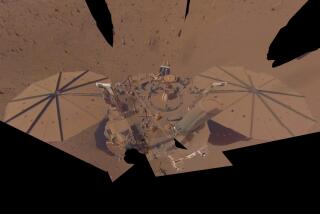Giant volcano with glacier on Mars may have been a nice place for life
- Share via
If life existed on Mars in the recent past, the best spot for it could have been on a giant volcano once encrusted with a glacier, according to a team of Brown University scientists using data from NASA’s Mars Reconnaissance Orbiter.
Microbial life could potentially have thrived for a time at the foot of Arsia Mons, a giant volcano about twice as tall as Mt. Everest, while the dinosaurs were just coming into their own on Earth, according to the study published in the journal Icarus. Though an active volcano may not sound particularly inviting, this combination of ice and heat would have contained massive, sheltered pockets of water -- from melted ice -- that could have lasted for hundreds or even a few thousand years.
“I was very excited,” lead author Kathleen Scanlon, a doctoral student and geologist at Brown University, said of the telltale signs left on the Martian surface that led to the team’s conclusions. “It’s all a really nice suite of land forms that together all point to the exact same process. So that was really cool.”
The findings come as NASA and other space agencies send more spacecraft and robots to the Red Planet to better understand how life-friendly Mars was in the past – and whether certain spots were better suited for living things than others.
Recent research has shown that the northwest side of Arsia Mons may have been covered in glacier ice, judging by marks in the terrain that resemble those left by glaciers in Antarctica’s McMurdo Dry Valleys. Around that time, about 210 million years ago, the volcano was active, spewing out lava from beneath the ground and melting some of the thick layer of glacial ice above.
Scanlon looked for certain shapes in the lava that would reveal the conditions under which the lava was coming out. She found a number of striking forms, including pillow-like lava, which extrude into giant rounded globules. On Earth, these pillows form under immense pressure at the bottom of the ocean. On Mars, it could mean the lava was under extreme pressure because it was squeezing out from underneath a glacier.
Two of the liquid bubbles caused by subsequent melting in the solid glacial ice would have held about 40 cubic kilometers of water each, making each of them roughly a third the size of Lake Tahoe. The water in these deposits could have remained liquid for centuries or more, the researchers said.
Microbes trapped in a subglacial lake, in freezing temperatures, total darkness and high pressures may sound extreme, but organisms do it on Earth too. A recent study of ice cores from a subglacial lake in Antarctica found DNA from a variety of microbes living more than 2 miles beneath the ice.
Of course, even a potentially life-friendly zone like Arsia Mons would not have lasted long on geological timescales. At its best, it could have potentially hosted microbes that had already emerged billions of years before, when Mars might have been warmer and wetter.
So the most important thing to understand is whether Mars was habitable more than 3.5 billion years ago, very early in its history, Scanlon noted. If not, then Arsia Mons’ habitability is probably moot. NASA’s Curiosity rover recently dug up some rock in Gale Crater and found some very watery environments rich in chemical building blocks for life. Just before the launch of the atmosphere-testing MAVEN mission last year, NASA released a stunning video of a past Mars, filled with puffy clouds and blue lakes.
But whether much of Mars was so life-friendly, and how long this wet era may have lasted, is up for debate. The less common these life-friendly spots were, and the shorter-lived they were, the less likely that life was able to emerge on the Red Planet. For now, the jury’s out on that mystery.
“If we can confirm that there was life around then, then our next question is, how long was it able to survive, and could there still be dormant microbes lying somewhere around on the surface?” Scanlon said. “I think Arsia Mons would be a good site to answer questions like that – if that does become a question.”







